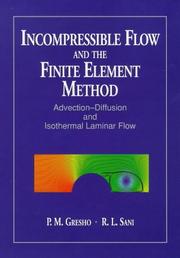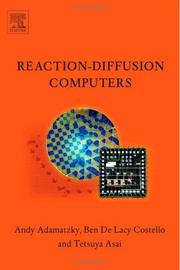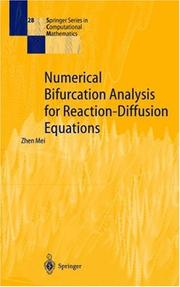| Listing 1 - 10 of 16 | << page >> |
Sort by
|
Book
ISBN: 0521831156 0521538440 Year: 2005 Publisher: Cambridge : Cambridge university press,
Abstract | Keywords | Export | Availability | Bookmark
 Loading...
Loading...Choose an application
- Reference Manager
- EndNote
- RefWorks (Direct export to RefWorks)
Book
ISBN: 3540133658 0387133658 3540389172 9783540133650 Year: 1984 Volume: 1072 Publisher: Berlin Springer
Abstract | Keywords | Export | Availability | Bookmark
 Loading...
Loading...Choose an application
- Reference Manager
- EndNote
- RefWorks (Direct export to RefWorks)
Partial differential equations --- 517 --- Analysis --- Biomathematics. --- Reaction-diffusion equations --- Numerical solutions. --- 517 Analysis

ISBN: 0471967890 9780471967897 Year: 1998 Publisher: Chichester : Wiley,
Abstract | Keywords | Export | Availability | Bookmark
 Loading...
Loading...Choose an application
- Reference Manager
- EndNote
- RefWorks (Direct export to RefWorks)
Finite element method. --- Fluid mechanics. --- Reaction-diffusion equations. --- Viscous flow. --- Laminar flow.
Book
ISBN: 1000049629 3731504340 Year: 2016 Publisher: KIT Scientific Publishing
Abstract | Keywords | Export | Availability | Bookmark
 Loading...
Loading...Choose an application
- Reference Manager
- EndNote
- RefWorks (Direct export to RefWorks)
In this book, stagnation flows on a catalytic porous plate is modeled one-dimensionally coupled with multi-step surface reaction mechanisms and molecular transport (diffusion and conduction) in the flow field and in the porous catalyst. Internal and external mass transfer limitations as well as possible reaction routes in the catalyst are investigated for CO oxidation, WGS reaction, partial and steam reforming of methane over Rh/Al?O?.
Book
ISBN: 9783642051340 9783642051333 Year: 2010 Publisher: Berlin, Heidelberg Springer Berlin Heidelberg
Abstract | Keywords | Export | Availability | Bookmark
 Loading...
Loading...Choose an application
- Reference Manager
- EndNote
- RefWorks (Direct export to RefWorks)
This book on numerical methods for singular perturbation problems - in particular, stationary reaction-convection-diffusion problems exhibiting layer behaviour is devoted to the construction and analysis of layer-adapted meshes underlying these numerical methods. A classification and a survey of layer-adapted meshes for reaction-convection-diffusion problems are included. This structured and comprehensive account of current ideas in the numerical analysis for various methods on layer-adapted meshes is addressed to researchers in finite element theory and perturbation problems. Finite differences, finite elements and finite volumes are all covered.
Mathematics. --- Numerical Analysis. --- Ordinary Differential Equations. --- Partial Differential Equations. --- Differential Equations. --- Differential equations, partial. --- Numerical analysis. --- Mathématiques --- Analyse numérique --- Finite volume method. --- Reaction-diffusion equations.
Book
ISBN: 0387907521 3540907521 1468401548 1468401521 9780387907529 9783540907527 Year: 1983 Volume: 258 Publisher: New York
Abstract | Keywords | Export | Availability | Bookmark
 Loading...
Loading...Choose an application
- Reference Manager
- EndNote
- RefWorks (Direct export to RefWorks)
Book
ISBN: 3319654675 3319654659 Year: 2017 Publisher: Cham : Springer International Publishing : Imprint: Springer,
Abstract | Keywords | Export | Availability | Bookmark
 Loading...
Loading...Choose an application
- Reference Manager
- EndNote
- RefWorks (Direct export to RefWorks)
This book presents several fundamental results in solving nonlinear reaction-diffusion equations and systems using symmetry-based methods. Reaction-diffusion systems are fundamental modeling tools for mathematical biology with applications to ecology, population dynamics, pattern formation, morphogenesis, enzymatic reactions and chemotaxis. The book discusses the properties of nonlinear reaction-diffusion systems, which are relevant for biological applications, from the symmetry point of view, providing rigorous definitions and constructive algorithms to search for conditional symmetry (a nontrivial generalization of the well-known Lie symmetry) of nonlinear reaction-diffusion systems. In order to present applications to population dynamics, it focuses mainly on two- and three-component diffusive Lotka-Volterra systems. While it is primarily a valuable guide for researchers working with reaction-diffusion systems and those developing the theoretical aspects of conditional symmetry conception, parts of the book can also be used in master’s level mathematical biology courses.
Mathematics. --- Partial differential equations. --- Biomathematics. --- Mathematical physics. --- Mathematical and Computational Biology. --- Partial Differential Equations. --- Mathematical Physics. --- Biology --- Mathematics --- Partial differential equations --- Physical mathematics --- Physics --- Math --- Science --- Differential equations, partial. --- Reaction-diffusion equations. --- Diffusion-reaction equations --- Equations, Reaction-diffusion --- Differential equations, Parabolic

ISBN: 9780444520425 0444520422 0080461271 9780080461274 9786610628902 1280628901 Year: 2005 Publisher: Boston : Elsevier,
Abstract | Keywords | Export | Availability | Bookmark
 Loading...
Loading...Choose an application
- Reference Manager
- EndNote
- RefWorks (Direct export to RefWorks)
The book introduces a hot topic of novel and emerging computing paradigms and architectures -computation by travelling waves in reaction-diffusion media. A reaction-diffusion computer is a massively parallel computing device, where the micro-volumes of the chemical medium act as elementary few-bit processors, and chemical species diffuse and react in parallel. In the reaction-diffusion computer both the data and the results of the computation are encoded as concentration profiles of the reagents, or local disturbances of concentrations, whilst the computation per se is performed via the spread
Reaction mechanisms (Chemistry) --- Chemical systems --- Reaction-diffusion equations --- Systems engineering. --- Engineering systems --- System engineering --- Engineering --- Industrial engineering --- System analysis --- Diffusion-reaction equations --- Equations, Reaction-diffusion --- Differential equations, Parabolic --- Systems, Chemical --- Chemistry, Physical and theoretical --- Phase rule and equilibrium --- Inorganic reaction mechanisms --- Mechanisms, Inorganic reaction --- Mechanisms, Reaction (Chemistry) --- Reaction mechanisms, Inorganic --- Chemical reaction, Conditions and laws of --- Data processing. --- Information technology. --- Design and construction

ISBN: 3540672966 3642086691 3662041774 Year: 2000 Publisher: Berlin ; : New York :. Springer,
Abstract | Keywords | Export | Availability | Bookmark
 Loading...
Loading...Choose an application
- Reference Manager
- EndNote
- RefWorks (Direct export to RefWorks)
Reaction-diffusion equations are typical mathematical models in biology, chemistry and physics. These equations often depend on various parame ters, e. g. temperature, catalyst and diffusion rate, etc. Moreover, they form normally a nonlinear dissipative system, coupled by reaction among differ ent substances. The number and stability of solutions of a reaction-diffusion system may change abruptly with variation of the control parameters. Cor respondingly we see formation of patterns in the system, for example, an onset of convection and waves in the chemical reactions. This kind of phe nomena is called bifurcation. Nonlinearity in the system makes bifurcation take place constantly in reaction-diffusion processes. Bifurcation in turn in duces uncertainty in outcome of reactions. Thus analyzing bifurcations is essential for understanding mechanism of pattern formation and nonlinear dynamics of a reaction-diffusion process. However, an analytical bifurcation analysis is possible only for exceptional cases. This book is devoted to nu merical analysis of bifurcation problems in reaction-diffusion equations. The aim is to pursue a systematic investigation of generic bifurcations and mode interactions of a dass of reaction-diffusion equations. This is realized with a combination of three mathematical approaches: numerical methods for con tinuation of solution curves and for detection and computation of bifurcation points; effective low dimensional modeling of bifurcation scenario and long time dynamics of reaction-diffusion equations; analysis of bifurcation sce nario, mode-interactions and impact of boundary conditions.
Reaction-diffusion equations --- Bifurcation theory. --- Numerical solutions. --- Numerical analysis. --- Mathematical analysis. --- Analysis (Mathematics). --- Mathematical physics. --- Numerical Analysis. --- Analysis. --- Theoretical, Mathematical and Computational Physics. --- Physical mathematics --- Physics --- 517.1 Mathematical analysis --- Mathematical analysis --- Mathematics
Book
ISBN: 3540171924 0387171924 3540473521 9783540171928 Year: 1986 Volume: 1224 Publisher: Berlin Springer
Abstract | Keywords | Export | Availability | Bookmark
 Loading...
Loading...Choose an application
- Reference Manager
- EndNote
- RefWorks (Direct export to RefWorks)
-Differential equations, Partial --- -Diffusion processes --- Nonlinear differential equations --- Diffusion processes --- Reaction-diffusion equations --- -51 Mathematics --- 51 --- Differential equations, Nonlinear --- Mathematics --- Markov processes --- Partial differential equations --- Nonlinear theories --- Congresses --- Mathematical models --- -Congresses --- -Markov processes --- 51 Mathematics --- Congresses.
| Listing 1 - 10 of 16 | << page >> |
Sort by
|

 Search
Search Feedback
Feedback About UniCat
About UniCat  Help
Help News
News